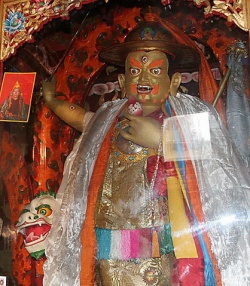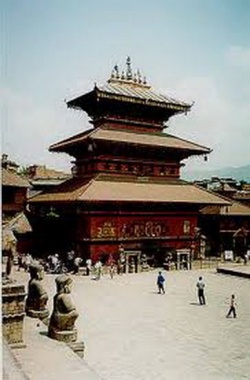Difference between revisions of "History of Drepung Monastery ..."
(Created page with " Situated a few kilometers outside Lhasa, Drepung monastery is one of the three great monasteries of the Gelugpa sect (along with Sera and Ganden [...") |
|||
| Line 1: | Line 1: | ||
| + | <nomobile>{{DisplayImages|742|2720}}</nomobile> | ||
| + | Situated a few kilometers outside [[Lhasa]], [[Drepung monastery]] is one of the three great [[monasteries]] of the [[Gelugpa sect]] (along with [[Sera]] and [[Ganden]] [[monasteries]]). | ||
| − | + | Its [[name]] literally means '[[rice heap]]'. | |
| − | It was once the largest [[monastery]] in the [[world]], housing betwwn 7,700 [[monks]] and 10,000 | + | It was once the largest [[monastery]] in the [[world]], housing betwwn 7,700 [[monks]] and 10,000 [[monks]]. |
| − | + | Today the population at [[Drepung Monastery]] has dwindled to a few hundred [[monks]]. | |
| − | The [[ | + | The [[monastery]] was founded in 1416 by [[Jamyang Choge Tashi Palden]] (1397-1449), one of [[Tsongkhapa's main disciples]]. |
| − | + | It was the [[principal]] seat of the [[Gelugpa school]] until the [[Great Fifth Dalai Lama]] [[constructed]] the [[Potala]]. | |
| − | Such was the importance of [[Drepung]] in [[ancient]] times that [[abbots]] of [[Drepung]] were [[traditionally]] [[enthroned]]. Many prominent [[Geluk]] [[Buddhist masters]] occupied the [[Throne | + | The [[Ganden Phodrang Palace]] situated at [[Drepung Monastery]] was [[constructed]] by the [[Second Dalai Lama]] in 1518. |
| + | |||
| + | It was the chief residence and governmental building until the inauguration of [[Potala Palace]] by the [[Great Fifth Dalai Lama]]. | ||
| + | |||
| + | In the {{Wiki|past}}, [[Drepung Monastery]] was known for the high standards of its {{Wiki|academic}} study, and was called the [[Nalanda of Tibet]], a reference to the great [[Buddhist monastic university]] of {{Wiki|ancient India}}. | ||
| + | |||
| + | Such was the importance of [[Drepung]] in [[ancient]] times that [[abbots]] of [[Drepung]] were [[traditionally]] [[enthroned]]. | ||
| + | |||
| + | Many prominent [[Geluk]] [[Buddhist masters]] occupied the [[Throne of Drepung]] ([[Drepung Tri]]), [[including]] [[Gendün Gyatso]] (1476–1541) and [[Penchen Sönam Drakpa]] (1478-1554 CE), the [[latter]] considered the most important [[Geluk]] thinker of his time. | ||
| + | |||
| + | His successor was none other than [[Sönam Gyatso]] (1543-1588 CE), the [[lama]] who would receive the official title of the [[Third Dalai Lama]]. | ||
In the late 1930s, the [[monastery]] at [[Drepung]] was divided into four {{Wiki|colleges}}, each housing [[monks]] from a different region, such as the [[Khampas]] and the [[Mongolians]], and so on. | In the late 1930s, the [[monastery]] at [[Drepung]] was divided into four {{Wiki|colleges}}, each housing [[monks]] from a different region, such as the [[Khampas]] and the [[Mongolians]], and so on. | ||
| − | [[Drepung]] is now divided into what are known as the seven great | + | |
| + | [[Drepung]] is now divided into what are known as the [[seven great colleges of Drepung]]: | ||
| + | |||
| + | <poem> | ||
| + | [[Gomang]], | ||
| + | [[Loseling]], | ||
| + | [[Deyang]], | ||
| + | [[Shagkor]], | ||
| + | [[Gyelwa]] or [[Tosamling]], | ||
| + | [[Dulwa]] and | ||
| + | [[Ngagpa]]. | ||
| + | </poem> | ||
| + | |||
| + | It can be a somewhat useful analogy to think of [[Drepung]] as a {{Wiki|university}} along the lines of [[Oxford]] or the {{Wiki|Sorbonne}} in the {{Wiki|Middle Ages}}, the various {{Wiki|colleges}} having different emphases, [[teaching]] [[lineages]], or [[traditional]] geographical affiliations. | ||
{{R}} | {{R}} | ||
http://www.everest-kailash.com/history-of-drepung-monastery.htm | http://www.everest-kailash.com/history-of-drepung-monastery.htm | ||
[[Category:Drepung Monastery]] | [[Category:Drepung Monastery]] | ||
Revision as of 08:30, 30 March 2016
Situated a few kilometers outside Lhasa, Drepung monastery is one of the three great monasteries of the Gelugpa sect (along with Sera and Ganden monasteries).
Its name literally means 'rice heap'.
It was once the largest monastery in the world, housing betwwn 7,700 monks and 10,000 monks.
Today the population at Drepung Monastery has dwindled to a few hundred monks.
The monastery was founded in 1416 by Jamyang Choge Tashi Palden (1397-1449), one of Tsongkhapa's main disciples.
It was the principal seat of the Gelugpa school until the Great Fifth Dalai Lama constructed the Potala.
The Ganden Phodrang Palace situated at Drepung Monastery was constructed by the Second Dalai Lama in 1518.
It was the chief residence and governmental building until the inauguration of Potala Palace by the Great Fifth Dalai Lama.
In the past, Drepung Monastery was known for the high standards of its academic study, and was called the Nalanda of Tibet, a reference to the great Buddhist monastic university of ancient India.
Such was the importance of Drepung in ancient times that abbots of Drepung were traditionally enthroned.
Many prominent Geluk Buddhist masters occupied the Throne of Drepung (Drepung Tri), including Gendün Gyatso (1476–1541) and Penchen Sönam Drakpa (1478-1554 CE), the latter considered the most important Geluk thinker of his time.
His successor was none other than Sönam Gyatso (1543-1588 CE), the lama who would receive the official title of the Third Dalai Lama.
In the late 1930s, the monastery at Drepung was divided into four colleges, each housing monks from a different region, such as the Khampas and the Mongolians, and so on.
Drepung is now divided into what are known as the seven great colleges of Drepung:
It can be a somewhat useful analogy to think of Drepung as a university along the lines of Oxford or the Sorbonne in the Middle Ages, the various colleges having different emphases, teaching lineages, or traditional geographical affiliations.
Source
http://www.everest-kailash.com/history-of-drepung-monastery.htm

